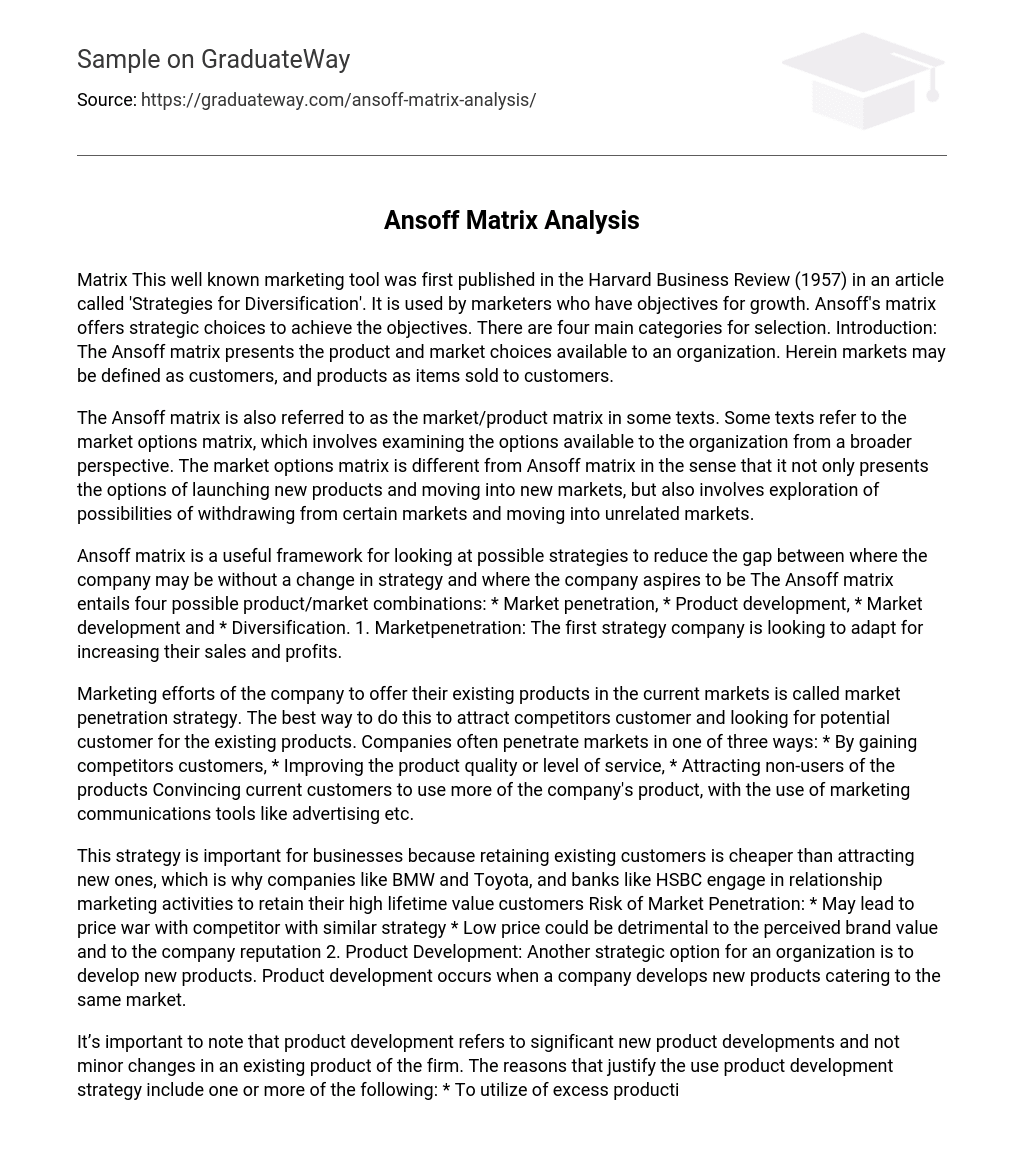Matrix This well known marketing tool was first published in the Harvard Business Review (1957) in an article called ‘Strategies for Diversification’. It is used by marketers who have objectives for growth. Ansoff’s matrix offers strategic choices to achieve the objectives. There are four main categories for selection. Introduction: The Ansoff matrix presents the product and market choices available to an organization. Herein markets may be defined as customers, and products as items sold to customers.
The Ansoff matrix is also referred to as the market/product matrix in some texts. Some texts refer to the market options matrix, which involves examining the options available to the organization from a broader perspective. The market options matrix is different from Ansoff matrix in the sense that it not only presents the options of launching new products and moving into new markets, but also involves exploration of possibilities of withdrawing from certain markets and moving into unrelated markets.
Ansoff matrix is a useful framework for looking at possible strategies to reduce the gap between where the company may be without a change in strategy and where the company aspires to be The Ansoff matrix entails four possible product/market combinations: * Market penetration, * Product development, * Market development and * Diversification. 1. Marketpenetration: The first strategy company is looking to adapt for increasing their sales and profits.
Marketing efforts of the company to offer their existing products in the current markets is called market penetration strategy. The best way to do this to attract competitors customer and looking for potential customer for the existing products. Companies often penetrate markets in one of three ways: * By gaining competitors customers, * Improving the product quality or level of service, * Attracting non-users of the products Convincing current customers to use more of the company’s product, with the use of marketing communications tools like advertising etc.
This strategy is important for businesses because retaining existing customers is cheaper than attracting new ones, which is why companies like BMW and Toyota, and banks like HSBC engage in relationship marketing activities to retain their high lifetime value customers Risk of Market Penetration: * May lead to price war with competitor with similar strategy * Low price could be detrimental to the perceived brand value and to the company reputation 2. Product Development: Another strategic option for an organization is to develop new products. Product development occurs when a company develops new products catering to the same market.
It’s important to note that product development refers to significant new product developments and not minor changes in an existing product of the firm. The reasons that justify the use product development strategy include one or more of the following: * To utilize of excess production capacity, * counter competitive entry, * maintain the company’s reputation as a product innovator, * exploit new technology, * To protect overall market share. Often one such strategy moves the company into markets and towards customers that are currently not being catered for.
Risk of Product Development: * Uncertainty of new technology * Teething trouble of the new product * Time pressure due to Competition 3. Market Development: Developing a new market for the existing company product is called market development strategy. This is the process of finding new market for the new customer to increase company performance by increasing sales and profits. Companies can develop market on geographical such as city,country,region,state etc and demographical such as age,sex,gender,class etc. * The sale of existing products in new international markets. * xploration of new segments of a market, new uses for the company’s products and services, * New geographical areas in order to entice new customers. For example, Arm & Hammer was able to attract new customers when existing consumers identified new uses of their baking soda. Risk of Market Development: * New market may be different than expected(especially new geographic area with cultural difference) * Costly modification may be required 4. Diversification: Diversification strategy is distinct in the sense that when a company diversifies, it essentially moves out of its current products and markets into new areas.
It is important to note that diversification may be into related and unrelated areas. Diversification can have 4 ways * Horizontal Diversification: this occurs when the company acquires of develop new products that could appeal to its current customer groups even though these new product may be technologically unrelated to teh existing product line * Vertical Diversification: The comapny moves into the business of its suppliers or into the busienss of its customers * Concentric diversification:
This results in new market product lines or services that have technological and marketing synergies with existing product lineseven though the products may appeal to a new customerr group * Conglomerate Diversification: This occurs when there is neither thechnological nor marketing synergy and this requires reaching new customer group. Sometime used by large companes seeking ways to balance a portfolio with non cyclical one. It is important to note that even unrelated diversification often has some synergy with the original business of the company.
The risk of one such strategy is that detailed knowledge of the key success factors may be limited to the company. While diversified businesses seem to grow faster in cases where diversification is unrelated, it is crucial to note that the track record of diversification remains poor as in many cases diversifications have been divested.. Therefore, diversification is a high-risk strategy as it involves taking a step into a territory where the criteria’s are alien to the company. The risks of diversification can be minimized by moving into related markets.





